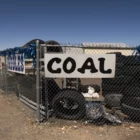Will carbon capture help clean New Mexico’s power, or delay its transition?
|
Shiprock, a sacred site to the Diné (Navajo People) is seen in the distance, the view mired in a smoky haze. Credit: Jeremy Wade Shockley / for the Energy News Network
As New Mexico lawmakers were putting the finishing touches on landmark legislation to help workers and communities transition from the closure of the state’s largest coal plant, the city of Farmington had other plans.
“We have reached a milestone that few people thought remotely possible,” City Manager Rob Mayes told the local newspaper in February 2019. An agreement was announced between the city and a New York holding firm called Acme Equities to keep the aging San Juan Generating Station operating past its scheduled 2022 retirement date. The state’s largest utility, Public Service Company of New Mexico, or PNM, had planned to retire the massive coal-fired power plant, eliminating hundreds of jobs and millions in local tax revenue that the 2019 Energy Transition Act intended to address. After working behind the scenes for months, though, local officials instead threw their support behind an obscure real estate hedge fund promising to keep the plant and its associated mine open by installing the largest carbon capture system on a power plant to date — by far. The $1.4 billion plan baffled energy-economics experts.



